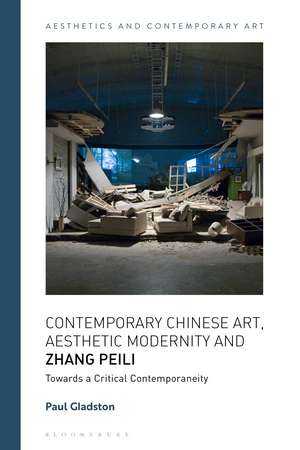Contemporary Chinese Art, Aesthetic Modernity and Zhang Peili: Towards a Critical Contemporaneity: Aesthetics and Contemporary Art
Autor Professor Paul Gladstonen Limba Engleză Paperback – 21 apr 2021
| Toate formatele și edițiile | Preț | Express |
|---|---|---|
| Paperback (1) | 217.82 lei 6-8 săpt. | |
| Bloomsbury Publishing – 21 apr 2021 | 217.82 lei 6-8 săpt. | |
| Hardback (1) | 658.52 lei 6-8 săpt. | |
| Bloomsbury Publishing – 16 oct 2019 | 658.52 lei 6-8 săpt. |
Preț: 217.82 lei
Preț vechi: 274.97 lei
-21% Nou
Puncte Express: 327
Preț estimativ în valută:
41.69€ • 43.36$ • 34.41£
41.69€ • 43.36$ • 34.41£
Carte tipărită la comandă
Livrare economică 14-28 aprilie
Preluare comenzi: 021 569.72.76
Specificații
ISBN-13: 9781350254015
ISBN-10: 1350254010
Pagini: 248
Dimensiuni: 156 x 234 mm
Greutate: 0.35 kg
Editura: Bloomsbury Publishing
Colecția Bloomsbury Academic
Seria Aesthetics and Contemporary Art
Locul publicării:London, United Kingdom
ISBN-10: 1350254010
Pagini: 248
Dimensiuni: 156 x 234 mm
Greutate: 0.35 kg
Editura: Bloomsbury Publishing
Colecția Bloomsbury Academic
Seria Aesthetics and Contemporary Art
Locul publicării:London, United Kingdom
Caracteristici
Uses art from China and the artist Zhang Peili to develop a new critical theory of aesthetic modernity
Notă biografică
Paul Gladston is the Judith Neilson Professor of Contemporary Art at the University of New South Wales, Australia.
Cuprins
AcknowledgementsIntroductionProlegomenon1. Critical Art and Aesthetics within China and EuroAmerica before Modernism2. Modernisms within and outside China3. Postmodernisms and Contemporaneity within and outside China4. Case Study: The Work of Zhang Peili and the Pond Association (Chi she)Conclusion: Towards a Critical Contemporaneity NotesBibliographyIndex
Recenzii
From the painstaking walk-through of theoretical issues and historical/cultural context appearing in his Prolegomenon, through the concise yet bracing conclusion, Paul Gladston's study of Zhang Peili and contemporaneity is far more than a mere biographical sketch of a single artist; it is a treatise on visual art of the present and China's particularized presence in that sphere. It is a landmark work both in terms of cultural-criticism and art-historical analysis.
Contemporary Chinese Art, Aesthetic Modernity and Zhang Peili is an important contribution to a critical discourse on contemporary art in the global context. Reading artworks by Zhang Peili through post-Enlightenment, poststructuralist as well as Neo-Confucian, Daoist and Zen-Buddhist lenses the author not only sheds light on multiple and entangled histories and epistemologies of Chinese art but also convincingly argues to conceive of contemporary art in general as constituted transculturally.
Gladston has taken the example of a single artist to anchor reflections on issues of immense contemporary importance, in particular the diversity of cultural histories that lead to the richness of global aesthetic positions. His scholarship actively helps to rescue cultural knowledge at risk of disappearing due to the lack of suitable academic platforms.
While emphasizing that our understanding of what is specific to China may be analysed with notions originating as much from China as from the West, the main strength of Gladston's book, particularly obvious in its ambitious prolegomenon, is to elucidate the idea of contemporaneity in the present debate about Chinese art.
With its judicious application of critical theory, the book will be essential reading for a better understanding of contemporary Chinese art and visual culture in the global contexts.
Contemporary Chinese Art, Aesthetic Modernity and Zhang Peili is an important contribution to a critical discourse on contemporary art in the global context. Reading artworks by Zhang Peili through post-Enlightenment, poststructuralist as well as Neo-Confucian, Daoist and Zen-Buddhist lenses the author not only sheds light on multiple and entangled histories and epistemologies of Chinese art but also convincingly argues to conceive of contemporary art in general as constituted transculturally.
Gladston has taken the example of a single artist to anchor reflections on issues of immense contemporary importance, in particular the diversity of cultural histories that lead to the richness of global aesthetic positions. His scholarship actively helps to rescue cultural knowledge at risk of disappearing due to the lack of suitable academic platforms.
While emphasizing that our understanding of what is specific to China may be analysed with notions originating as much from China as from the West, the main strength of Gladston's book, particularly obvious in its ambitious prolegomenon, is to elucidate the idea of contemporaneity in the present debate about Chinese art.
With its judicious application of critical theory, the book will be essential reading for a better understanding of contemporary Chinese art and visual culture in the global contexts.












